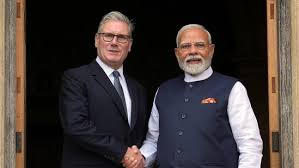India, UK sign free trade deal as PM Modi meets British counterpart Starmer

On July 24, 2025, India and the United Kingdom signed a landmark Free Trade Agreement (FTA). The historic deal took place during Indian Prime Minister Narendra Modi’s visit to the UK. UK Prime Minister Keir Starmer witnessed the signing at Chequers, the British Prime Minister’s country residence.
This comprehensive trade agreement marks a new era in India-UK relations. It promises stronger economic ties, increased bilateral trade, and new investment opportunities. The deal also reflects the countries’ desire to deepen their strategic partnership after Brexit.
Details of the India-UK Free Trade Agreement
The India-UK FTA is India’s first major trade agreement with a European country. For the UK, it is the fourth significant trade pact post-Brexit. The deal aims to remove tariffs, reduce trade barriers, and make trade smoother between the two nations.
Tariff Cuts and Market Access
India will cut tariffs on many British goods, lowering its average tariff from 15% to just 3%. One notable reduction is on Scotch whisky and English gin. These products currently face duties up to 150%. Under the agreement, tariffs will drop to 75% at first and eventually fall to 40% after ten years.
Automobile tariffs will also be reduced sharply, from over 100% to 10%, but under a quota system.
On the UK side, exporters gain better access to India’s huge market. Key sectors like aerospace, advanced manufacturing, and technology will benefit. Indian exporters will enjoy duty-free entry for textiles, footwear, clothing, and food products — vital areas for India’s economy and employment.
Economic Impact and Job Creation
The deal is expected to increase bilateral trade by £25.5 billion annually by 2040. The UK government predicts it will add around £5 billion each year to the UK economy. This growth will benefit regions across the UK and create over 2,200 jobs.
In addition, the agreement should stimulate nearly £6 billion in new investment and export chances for British businesses.
Strategic and Geopolitical Importance
This FTA strengthens the strategic partnership between India and the UK. Both countries aim to diversify their international alliances and reduce dependence on traditional trade blocs.
For India, the deal opens a pathway to stronger ties with Europe through the UK. For the UK, it is a key step in becoming a global trading nation after leaving the EU.
Prime Minister Keir Starmer called the deal “the most significant post-Brexit trade agreement the UK has signed.” He highlighted its potential to secure thousands of British jobs and boost economic growth.
The Negotiation Journey
Talks for the India-UK FTA started soon after the UK left the EU in 2020. Both countries were eager to strengthen ties based on shared democratic values and complementary economic strengths.
Negotiations lasted over three years. They covered tariffs, intellectual property rights, labor standards, and regulatory cooperation. Despite challenges, negotiators found a balance that protects India’s domestic industries while improving market access for the UK.
The agreement also supports India’s “Make in India” campaign by promoting exports and attracting foreign investment. For the UK, it helps diversify trade in a changing global economy.
Responses from India and the UK
At the signing ceremony, PM Modi praised the FTA as a symbol of strong friendship and partnership between India and the UK.
UK business leaders welcomed the deal. They expect it to lower costs, simplify supply chains, and create new business opportunities. Indian exporters were also pleased, as tariff cuts will make their goods more competitive in the UK market.
Experts see the agreement as a foundation for cooperation in technology transfer, innovation, and sustainable development. The partnership could become a model for future trade agreements.
Challenges and Future Outlook
While the FTA is a big step forward, experts warn that both countries need to work hard to maximize its benefits.
India will have to improve customs processes, upgrade infrastructure, and align regulations. This will help exporters take full advantage of the deal.
UK companies will need to understand India’s unique market dynamics. They must adapt to diverse consumer preferences and regulatory systems.
The agreement’s success also depends on ongoing diplomatic goodwill. Both sides must remain flexible amid global economic and geopolitical changes.
Still, the India-UK FTA lays a strong foundation for future growth. It could reshape trade not only between these two nations but across the region.
Conclusion
The India-UK Free Trade Agreement marks a historic moment for international trade. It reflects both countries’ goals of economic growth, job creation, and stronger strategic ties.
As PM Modi and PM Starmer formalize this partnership, the deal promises to transform commerce and deepen relations between two of the world’s fastest-growing economies.
This landmark FTA opens new doors for trade and symbolizes a shared vision of prosperity, innovation, and cooperation for years ahead.






